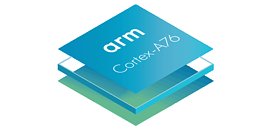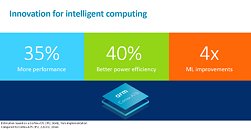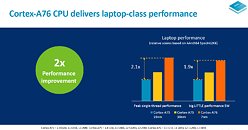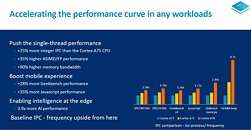Friday, June 1st 2018
An ARM to Rule Them All: ARM 76 To Challenge x86 Chips in the Laptop Space?
ARM has announced their next, high-performance computing solution with their A76 design, which brings another large performance increase to the fledgling architecture. having been touted for some time as a true contender to the aging x86 architecture, ARM has had a way of extracting impressive performance increases with each iteration of its computing designs, in the order of 20% do 40% performance increases in an almost annual basis. Compare that to the poster-child of x86 computing, Intel, and its passivity-fueled 5 to 10% yearly performance increases, and the projections aren't that hard to grasp: at some point in time, ARM cores will surpass x86 in performance - at least on the mobility space.
The new ARM A76 design, to be manufactured on the 7 nm process, brings about a 35% increase in performance compared to last years' A75. This comes with an added 40% power efficiency (partly from the 10 nm to 7 nm transition, the rest from architecture efficiency and performance improvements), despite the increase to maximum 3.0 GHz clocks. With the added performance, ARM is saying the new A76 will deliver 4x the Machine Learning performance of its previous A75 design.Adding to those CPU performance improvements, is ARM's Mali-G76 GPU solution, which also packs some 30% increases in performance density (meaning, for the same silicon footprint, added 30% performance), accompanied by 30% better energy efficiency and 2.7x increased Machine Learning performance for GPU-accelerated workloads. The new GPU architecture supports up to three execution engines per shader core, features a dual texture mapper, presents configurable 2-4 slices of L2 cache, and supports up to 20 "cores" in devices for process and workload distribution.This combination of CPU (with the ARM A76) and GPU (with the Mali-G76) performance improvements mean that ARM is now within spitting distance of x86 solutions in the mobile space; this, and the future performance projections should ARM be able to keep its development and performance improvement pace, may be one of the reasons why Microsoft invested the way it did in adding ARM support for its Windows operating system in recent times. ARM solutions that employ Microsoft's OS do provide better battery life than their x86 counterparts, and with the latest ARM 76 improvements, which are seemingly more significant than any x86 performance and efficiency increases in recent times, may well mean a push for x86 towards higher levels of required performance, leaving the entry productivity and content consumption scenarios for ARM-powered devices and architectures.
Sources:
AnandTech, Tom's Hardware
The new ARM A76 design, to be manufactured on the 7 nm process, brings about a 35% increase in performance compared to last years' A75. This comes with an added 40% power efficiency (partly from the 10 nm to 7 nm transition, the rest from architecture efficiency and performance improvements), despite the increase to maximum 3.0 GHz clocks. With the added performance, ARM is saying the new A76 will deliver 4x the Machine Learning performance of its previous A75 design.Adding to those CPU performance improvements, is ARM's Mali-G76 GPU solution, which also packs some 30% increases in performance density (meaning, for the same silicon footprint, added 30% performance), accompanied by 30% better energy efficiency and 2.7x increased Machine Learning performance for GPU-accelerated workloads. The new GPU architecture supports up to three execution engines per shader core, features a dual texture mapper, presents configurable 2-4 slices of L2 cache, and supports up to 20 "cores" in devices for process and workload distribution.This combination of CPU (with the ARM A76) and GPU (with the Mali-G76) performance improvements mean that ARM is now within spitting distance of x86 solutions in the mobile space; this, and the future performance projections should ARM be able to keep its development and performance improvement pace, may be one of the reasons why Microsoft invested the way it did in adding ARM support for its Windows operating system in recent times. ARM solutions that employ Microsoft's OS do provide better battery life than their x86 counterparts, and with the latest ARM 76 improvements, which are seemingly more significant than any x86 performance and efficiency increases in recent times, may well mean a push for x86 towards higher levels of required performance, leaving the entry productivity and content consumption scenarios for ARM-powered devices and architectures.








74 Comments on An ARM to Rule Them All: ARM 76 To Challenge x86 Chips in the Laptop Space?
Only runs Microsoft applications Microsoft ported to ARM and the app store. I couldn't even build my own programs in Visual Studio and run it on there because Microsoft has to sign it for it to execute. Windows 10 S I don't think even supports that much--it's strictly Windows Store apps.
Granted, Microsoft had a device with an ARM processor that did x86 emulation. I don't know it worked nor how well it worked.
But no, ARM is no threat to x86 any more than it already is. There's some things x86 does better than ARM and some things ARM does better than x86.
No???? I'll go get my coat.
I'm not up to date as I should be in the ARM space... just curious if this is a fanboy comment, or true.
I do know from my recent experience with iOS development, especially using Metal's compute kernels, that the newer SoC seems to have some hidden tricks to force developers to be more efficient. Otherwise the app starts spewing out random bugs when the same piece of code runs perfectly fine using older iPhones and iPads, just with lower framerates.
Windows 10 S takes the same concept but is platform agnostic and is marketed for the security aspect of being so restrictive.
Just look at snapdragon 835 laptops, which is an a73. Is it slower than even a Intel N3450 which is based on Silvermont arch, lowest tier of performance there is.
If A76 is twice, even three times faster it will still be slower than any i3 from Ivy Bridge era. So please, cut the crap...
HAHAHAHA lol no. Anyone who thinks MIPS-architecture chips will ever compete with x86 in terms of performance is delusional.
BTW it's "Arm" now, not "ARM". They rebranded because apparently uppercase is no longer cool... I guess someone should tell NVIDIA.
:fear:
Although , Geekbench is a terrible benchmark.
...
Well, I mean minus the "FEED ME ALL YOUR ENERGY!" part...